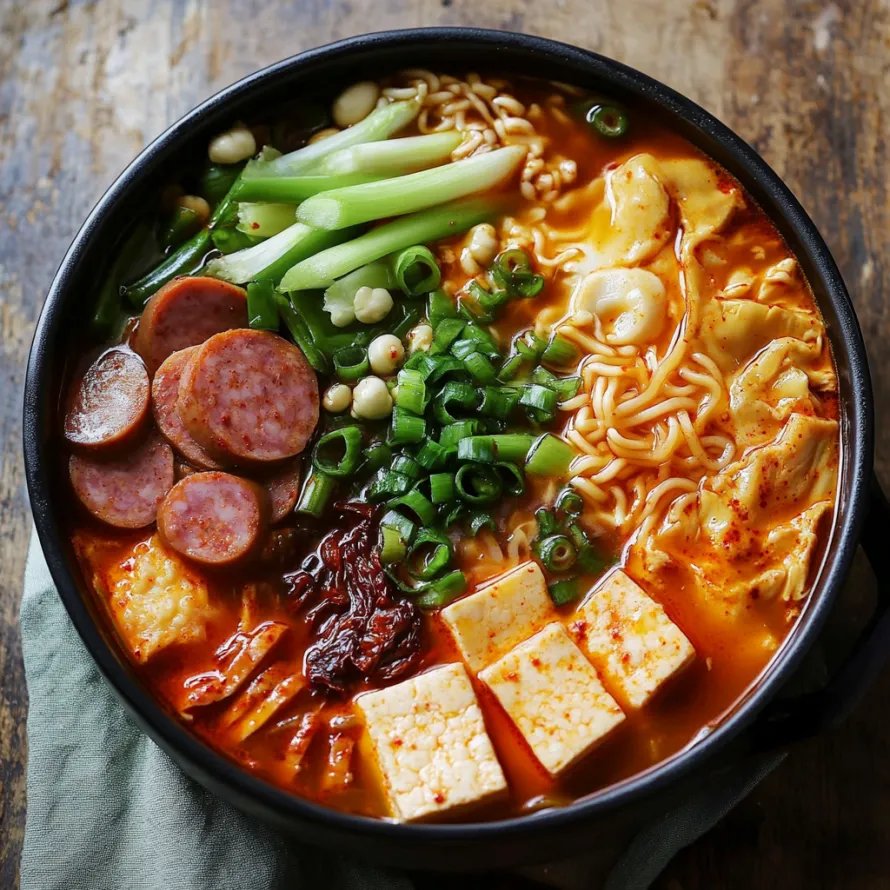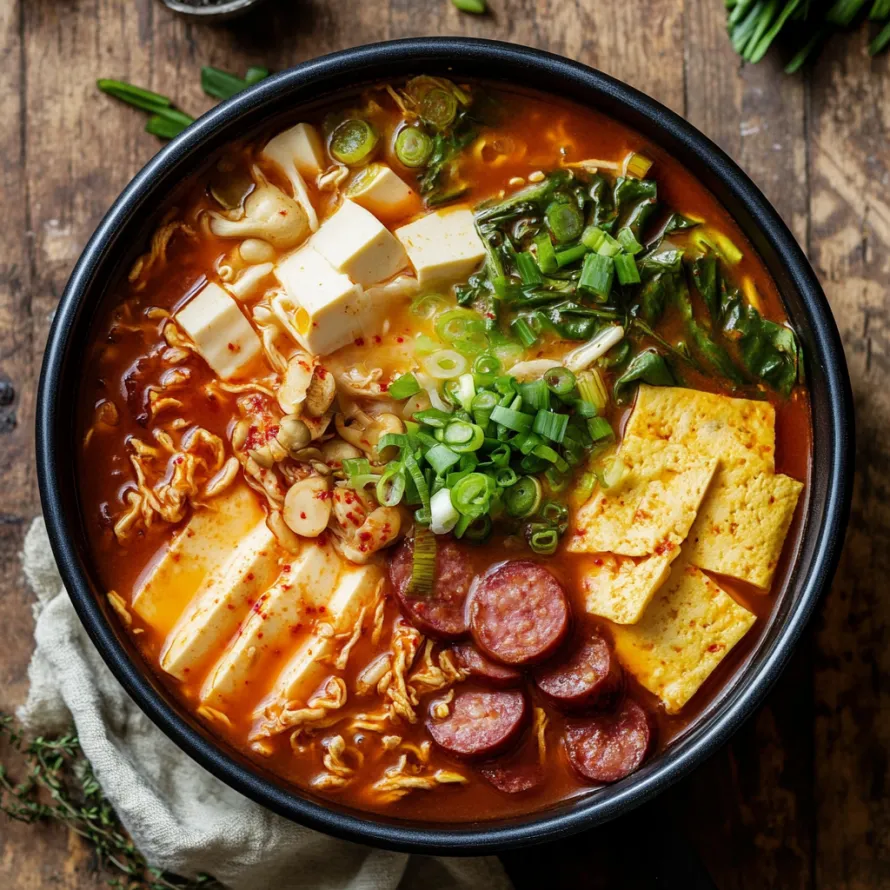 Pin it
Pin it
This colorful Budae Jjigae is all about tossing together some wild pantry staples and ending up with a dish that's weirdly harmonious. Every scoop packs a punch—crunchy kimchi, hearty Spam, the gentle burn of chili flakes, and gooey cheese just lounging in a spicy, bubbling broth. The real magic is how all these different textures and flavors somehow blend in the pot and invite everyone to dig in and get cozy together.
My first run-in with Budae Jjigae was on a freezing night at a tiny Seoul spot. The pot came roaring over, broth bubbling like crazy. The owner shared how folks got crafty after the war, mixing G.I. rations with local flavors. It blew my mind that something started out as a way to get by became this beloved classic. Now every time I throw it together at home, the kitchen fills with that same warmth—and my friends are always ready, chopsticks in hand, for the bubbling feast.
Epic Broth Prep
- Aged kimchi: Brings some real zing and body to everything.
- SPAM: That unmistakable salty-savory bite everyone expects here.
- Chicken stock: Keeps things light so every topping gets its own moment.
How to Pull It All Together
- Finishing with Cheese:
- Lay cheese slices on top just before serving so they get all melty and nice.
- Noodle Drop Timing:
- Toss in your ramen only when everything’s boiling hard—otherwise the noodles go mushy.
- Stock Pouring Move:
- Gently add your broth along the edges so you don’t wash all the flavor bits away.
- Pile-Up Strategy:
- Put all your spicy stuff right in the middle—and let it spread out as everything cooks.
Had a Korean friend's grandma keeping a close eye when I tried making this over at her place. At first, she seemed skeptical watching an American mess with her stew. But when that pot started bubbling, she cracked a smile. Over dinner, she told us stories about how Budae Jjigae grew out of tough times and now everyone loves it.
 Pin it
Pin it
Meaningful Origins Tale
This wild stew came about during the Korean War, when folks had to get super inventive with what they had around. Mixing different foods led to this creative mashup. These days, Budae Jjigae shows how adapting to tough times can spark the best food ideas ever.
Sharing Table Vibes
Level up dinner—put your Budae Jjigae piping hot in the middle of the table. Set out some long chopsticks and big spoons so everyone gets to scoop straight from the pot all night.
Inspired Twist Options
- Mix Up The Region: Go full seafood for a Busan feel, or sneak in some fermented bean paste for that earthy kick.
- Easy Diet Swaps: Swap in plant-based sausages and plenty of tofu so even vegetarians get in on the action.
Simple Ways to Serve
- Dishing Out At The Table:
- Flat, wide pots make everything easier to see and grab.
- Fresh Sides To Pair:
- Hand out lettuce or perilla leaves for wrapping up tasty bites right from the pot.
 Pin it
Pin it
For me, Budae Jjigae is what food should be: a mashup of stories, bringing folks together, and flipping basic ingredients into something unforgettable. It has roots in resilience—and by now, everyone's wild about how awesome the unexpected flavors come together.
Frequently Asked Questions
- → Can I substitute any ingredients in Budae Jjigae if I can't find them?
- For sure, swap in what you've got! Budae Jjigae began as a way to use whatever was handy. If rice cakes are tough to get, try rice noodles or just skip them. Any mushrooms will work—even basic white ones. No gochugaru? Use your regular red pepper flakes with a sprinkle of paprika. Gochujang missing? Mix up a bit of miso with sriracha. Same goes with the cheese: any melty kind does the trick. The kimchi and spicy sauce are the backbone for flavor.
- → How spicy is authentic Budae Jjigae and can I adjust the heat level?
- Usually, it's got a good kick but you control the fire. Cut back on gochugaru and gochujang for less spice, or trade some with paprika for color without extra heat. Fiery food lovers can crank up both the gochugaru and gochujang, or sprinkle in some chopped chilies. Cheese and noodles calm the heat, so it doesn't smack you all at once—it's more of a cozy, build-up kind of spicy.
- → Can I make Budae Jjigae vegetarian or vegan?
- Absolutely! You can totally go meatless. Just toss in tofu, taste-packed mushrooms, or your go-to plant-based sausage instead of the usual spam and wieners. Use veggie broth and grab vegan cheese if you want to skip dairy. Double-check your kimchi to make sure it's got no fish bits (or make your own!). Pick vegan ramen too, since most regular ones sneak in animal stuff. Gochujang and the rest are often vegan, but scan the labels to be sure.
- → What's the best pot to use for cooking Budae Jjigae?
- You want a big, flat pot with a lid for this stew, so all your stuff sits together and soaks in the broth. If you've got a Korean clay pot or wide hot pot, awesome! But even a shallow skillet or Dutch oven works. Plan to eat at the table? Pick a pot that looks nice and heats evenly—just don't use one that could crack on a burner.
- → How do I store and reheat leftover Budae Jjigae?
- When you're done, let the stew cool, dump it in a sealed tub, and chill for up to two days. Noodles might get soft as they sit, so when you warm things up, splash in some extra broth or water. Warm it slowly on the stove so the noodles and tofu don't get tough or rubbery (skip the microwave if you can). Want the freshest bowl later? Keep noodles out and cook only what you'll eat, adding new ones to leftovers.
- → What side dishes pair well with Budae Jjigae?
- Steamed rice is a staple side. For banchan, go with more kimchi, crisp cucumber salad, seasoned bean sprouts, garlicky spinach, or pickled radish. It's fun to scoop stew bites up in lettuce or perilla leaves with a dab of ssamjang. Pair up with cool radish soup for contrast, and sip roasted barley tea or a cold beer to round out the meal.
